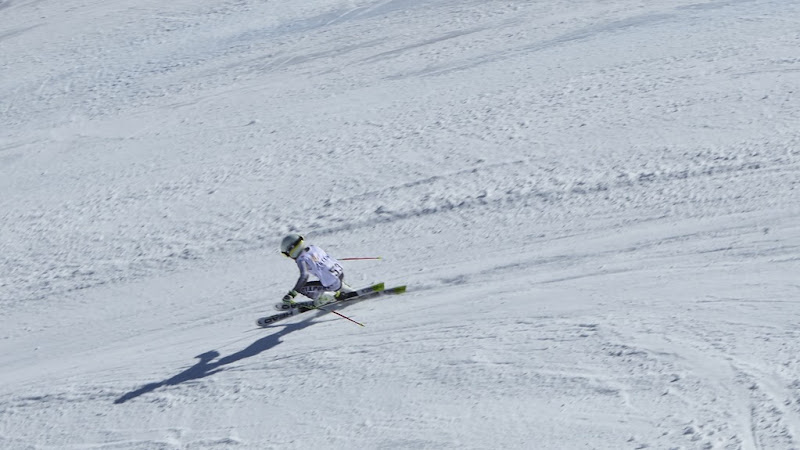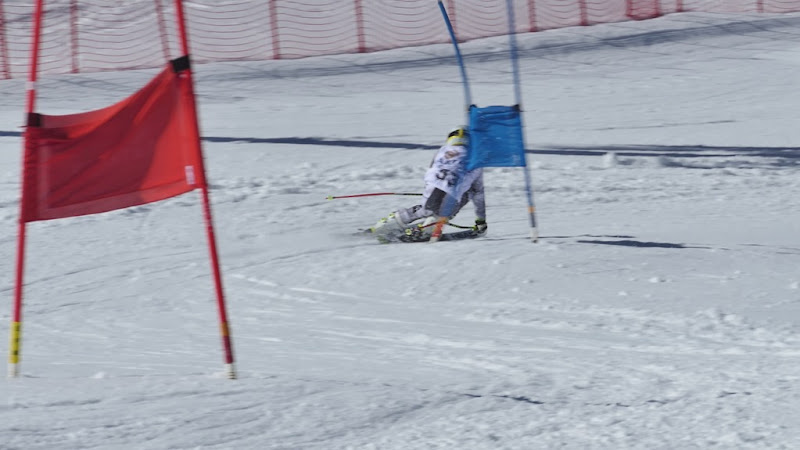Checking my blog it’s exactly three years since Chantelle skied – not having skied at all since those sessions. Starting with a refresher course was a good idea because she was very rusty to begin with. Although bringing Chantelle back up to speed in a solid way was the goal Andrew was clearly not standing comfortably on his skis so that bugged me enough to pull him into the session as well.
Video Scenes…
- Chantelle pivoting – outside ski
- Chantelle working on dynamics and coordination
- Andrew working on dynamics and coordination
- Chantelle on the balls of the feet – ankles extended
- Andrew on the balls of the feet – fronts of the skis – improved stance
- Chantelle – filming tendency to stem the left ski at the start of the turns
Dynamics
Once Chantelle readjusted to sliding again we did a basic revision of dynamics from scratch http://skiinstruction.blogspot.fr/p/dynamics.html
Theory and understanding had to be reinforced just as much as the physical side of things as Chantelle was not clear on the issues. The link above covers all the basics so I won’t explain too much here and as Chantelle progressed well we were able to move on quickly and while doing so her confidence was increasing all the time.
Pivoting
When opportunities arose Chantelle was asked to sideslip and to stand on the inside edges of both feet – moving the centre of mass downhill to make the skis slip. This was to accustom the body to the side slipping skills necessary for pivoting.
There is a complete basic coverage of pivoting at the following link… http://skiinstruction.blogspot.fr/p/pivot.html Chantelle was assisted thorugh a complete pivot with me providing support for her centre of mass. On her own, the downhill pole was planted to take over my job and to support her centre of mass. After a few practices Chantelle was able to pivot neatly on her own.
Dynamics function when the ski has forward speed and generates “lifting up” power – so there is a relationship between actively falling over and the ski lifting you back up. When pivoting there is no forwards motion of the ski – it sideslips (from the uphill edge) into the turn at the front being pulled by the centre of mass – which is supported by the pole plant and tension through the legs.
Dynamics and pivoting are opposites in ski use and function and when clearly understood then then can be blended intelligently.
Looking over the Col de Petit St Bernard into the fog above la Rosière ski station and into the Asota valley in front of Mont Blanc. There is frequently a huge fog bank in this location.
Feet /Boots
- Ankle is a hinge
- Weight on front of heel
- Bending at knee and hip – feet muscles and anterior tibialis tensioning – strong ankle
- Rolling feet from subtaler joints (between heel and ankle)
- Feeling connection with adductor muscles (insides of upper legs)
- Feeling core muscles from using both sets of adductors and both feet on inside edges
- Rising up on balls of the feet – still able to keep strong ankles and roll feet on edge due to the support from the inclined boot sole
Andrew’s boots had to be canted as the were strongly under-edged. The shafts were canted outwards. Applying my own test – legs straight - unloaded – feet hip width apart – hips flexed – the soles of the boots were now flat. Shops and “experts” try to do this with you standing and flexing but this canting issue is only related to bone structure which can only be seen with the leg locked out straight.
Dynamics Part 2 – Perpendicularity
We moved on fairly promptly to the issue of “perpendicularity” – or getting into “neutral” and over the lower ski into the next turn. This is an even more important part of dynamcis than the first part. This still didn’t stop Chantelle from being trapped on the backs of her boots at times but it did bring her more fluidity and security. If you get over the lower ski then the start of the next turn is easy and you can use the fronts of the skis – otherwise you tend to be caught in the back seat. Chantelle had a tendency to avoid coming over the right ski/leg and so stem out the left ski – which is a “pushing out action” that we try to avoid. Much of the pivoting exercise is to cultivate a “pulling in action”.
Illusions to avoid
Centrifugal force does not exist – it is a “fictional force” – sometimes called a d’Alembert or Inertial force. Basically it’s a mathematical trick. What we really do have is “centripetal” force – acting like a rope pulling you inwards away from a straight line. All skiing actions have to encourage this “rope” action of the ski deflecting you inwards – so you move in and pull everything in. Unfortunately the illusion of centrifugal force is strong and so people respond by pushing outwards against it in a form of resistance – or pushing the ski out with the abductor muscles and even moving the body outwards to “transfer weight” and twisting everything inwards – all going neatly along with this illusion and a whole pile of commonly taught nonsense that panders to the emotions instead of overcoming them.
Angulation
While Chantelle had a tendency to rotate and twist into the turn Andrew as simply confused at the hip joints – with almost no understanding of that area of his body. There’s clearly nothing wrong with him it’s just that he’s never had to think about it. We had to work on posture – the relationship between the pelvis and the lower back – and then be able to release and flex the hips separately from this. When Andrew could do this standing on one leg then he could use the head of that femur like a fuclrum to support and pivot the entire upper body. This is how hip angulation is generated in skiing – allowing control of rotation and more accurate and powerful development of tighter turns. (This stance really comes from skating actions where the hip is pulled in under the body)
The above movement was refined and simplified on the slopes by simply pulling back the outside hip during the turn – to prevent the ski from pulling it around in front of the ribs. I got both Chantelle and Andrew to pull up against my weight in both positions and to feel how the slight pulling back of the hip allowed the core muscles to protect the body by reflex.
The order of coordination was now…
- Feet (balls) rolling
- Adductor muscles
- Hip/angulation
- Centre of mass
It’s easy to think of that specifically on the outside leg at the start of a new turn. However it’s better reversing this and starting from the centre because this alignes the femur correctly and sets everything up almost automatically.
Stance
Both Chantelle and Andrew found it more successful to stand up on the balls of the feet. Andrew’s “agricultural” skiing stance – skis wide apart and rounded back – complete vanished. The outside leg was still “resisting” and a bit locked but working on “pulling in“ should help that to ease off. For a while I had Andrew tilted far forwards over the fronts of his skis to feel them – then back off – but to still retain the fact that we need to use the fronts. When there is inclination and angulation then we are safe on the fronts.
Chantelle by now also appeared to be off the backs of her ski boots – through the combination of dynamcis and standing with a strong ankle on the balls of her feet. You can feel the subtaler joints better when on the front of the heels – but it’s hard to stay in contact with the fronts of the skis that way.
Working the Turns
The centre of mass needs to be driven inwards even more strongly as the turn develops. After passing the fall line the second half of the turn is about resisting gravity so the forces from the ski “lifting up” (and so indirectly out) of the turn are much stronger. The skier has to drive that centre of mass even more powerfully inwards – but peope who are not aware of this or who have never raced in poles always do the opposite and give up. Chantelle had this issue and was very unstable on steep slopes because of it. We managed to get some work on this in during the final run of the day.
Mindful Skiing
All the pysical details of the body parts and relationships – and the relationship with the centre of mass – must be the whole focus when skiing. What this does is it centres the mind and removes distractions and tensions. When the mind meditates like this on body awareness then it unlocks performance potential. We relate to the terrain and surrounding environment far more efficiently this way compared to allowing them to be a distraction. The main thing is that mindful skiing allows us to grow awareness and never become bored or frustrated with skiing or being on the mountain – it lets you de-stress from work and become totally absorbed in the present. That’s why it’s so important to be working with correct information.
The Rocher du Charvet on the right with Pisteur’s couloir in the shadows.








